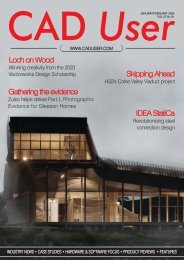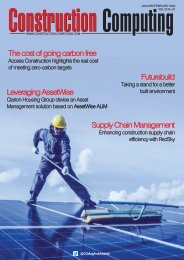Jan-Feb-Mar 2021
You also want an ePaper? Increase the reach of your titles
YUMPU automatically turns print PDFs into web optimized ePapers that Google loves.
OPINION<br />
A FORWARD-LOOKING GUIDE TO BUYING IT<br />
EQUIPMENT FOR SMES<br />
WORKING OUT WHEN TO UPGRADE BUSINESS TECHNOLOGY IS<br />
NOT JUST ABOUT ITS PHYSICAL CAPABILITY. SIMON MICHIE AT<br />
PULSANT EXPLAINS WHY<br />
Working out when to upgrade<br />
business technology is not just<br />
about physical capability but also<br />
about supportability for new applications.<br />
As many SMEs understand, components<br />
inevitably degrade over time, leading to<br />
unexpected interruptions and in the worstcase<br />
scenarios, significant data loss and<br />
the serious consequences that come with<br />
that.<br />
A hard drive (HDD) lasts about six years<br />
as its spinning disks wear out after<br />
continuous usage, while the integrity of the<br />
data stored on an aging disk deteriorates<br />
due to excessive wear, the presence of<br />
contaminants, radiation and heat.<br />
Comparing the lifetime of a solid-state<br />
drive (SSD) is complex because its length is<br />
greatly determined by the total terabytes of<br />
data written onto it. As a result, in order to<br />
minimise the risk from aging components it<br />
is essential that the performance of<br />
applications is monitored regularly and<br />
SME's are up to date on the options<br />
available to them.<br />
If the technology had a reasonable<br />
specification when purchased, then unless<br />
it has become incompatible with a<br />
company's chosen new application (more<br />
likely due to an aging operating system<br />
than the hardware), IT staff should be<br />
monitoring the performance of systems<br />
and applications and assessing whether<br />
any perceived slow-down is affecting<br />
employees' efficiency. User satisfaction is<br />
crucial for the success of IT initiatives, so<br />
performance monitoring shouldn't be<br />
limited to tracking IT resources such as<br />
CPU, memory, disk, etc, but all aspects of<br />
the experience. To do this, IT operators<br />
and administrators can assess end-user<br />
availability and performance with the aid<br />
of user experience monitoring software.<br />
If the performance does remain<br />
acceptable, then the only real driver is<br />
reliability which is affected by ageing<br />
components such as fragile motherboards<br />
and on-board circuitry, power supplies or<br />
disk drives. Keeping a close check on<br />
reliability across all the hardware and<br />
determining the failure rate may well make<br />
the decision an obvious one, even if the<br />
equipment itself is still capable of<br />
operating the software that the business<br />
depends upon.<br />
ON-PREMISE VERSUS CLOUD:<br />
THE COSTS<br />
Housing a server on-premise is an<br />
expensive undertaking which involves<br />
everything from air conditioning systems to<br />
power distribution, networking and power<br />
backup. All of this requires significant<br />
levels of capital investment and on-going<br />
operating expense.<br />
Alternatively, cloud has an array of<br />
advantages such as greater agility, cost<br />
savings and faster time to market. There's<br />
no need for hardware in the virtualised<br />
environment and businesses can pay for<br />
storage which is cheap and easy to do.<br />
Apart from paying for bandwidth and<br />
connectivity, there is no cost associated<br />
with getting data into the cloud; however,<br />
there can be unbudgeted costs associated<br />
with getting data out of the cloud. The<br />
processing of information and returning<br />
results is where costs can often start to rise.<br />
A full move to the cloud may not always<br />
be desirable because of concerns over<br />
security and control and in this case, the<br />
answer is often colocation. By moving their<br />
servers to a trusted vendor's facility, SME's<br />
can uphold absolute control over their<br />
data without maintaining a costly,<br />
dedicated, potentially insecure, in house<br />
data centre.<br />
The key cost advantage of colocation is<br />
that providers host multiple customers<br />
within each data centre, allowing them to<br />
22 NETWORKcomputing JANUARY/FEBRUARY <strong>2021</strong> @NCMagAndAwards<br />
WWW.NETWORKCOMPUTING.CO.UK

















